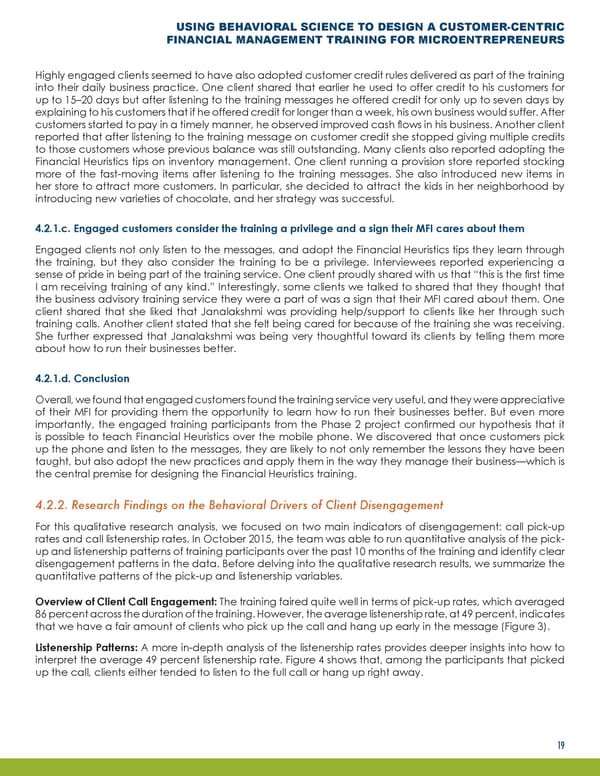USING BEHAVIORAL SCIENCE TO DESIGN A CUSTOMER-CENTRIC FINANCIAL MANAGEMENT TRAINING FOR MICROENTREPRENEURS Highly engaged clients seemed to have also adopted customer credit rules delivered as part of the training into their daily business practice. One client shared that earlier he used to offer credit to his customers for up to 15–20 days but after listening to the training messages he offered credit for only up to seven days by explaining to his customers that if he offered credit for longer than a week, his own business would suffer. After customers started to pay in a timely manner, he observed improved cash flows in his business. Another client reported that after listening to the training message on customer credit she stopped giving multiple credits to those customers whose previous balance was still outstanding. Many clients also reported adopting the Financial Heuristics tips on inventory management. One client running a provision store reported stocking more of the fast-moving items after listening to the training messages. She also introduced new items in her store to attract more customers. In particular, she decided to attract the kids in her neighborhood by introducing new varieties of chocolate, and her strategy was successful. 4.2.1.c. Engaged customers consider the training a privilege and a sign their MFI cares about them Engaged clients not only listen to the messages, and adopt the Financial Heuristics tips they learn through the training, but they also consider the training to be a privilege. Interviewees reported experiencing a sense of pride in being part of the training service. One client proudly shared with us that “this is the first time I am receiving training of any kind.” Interestingly, some clients we talked to shared that they thought that the business advisory training service they were a part of was a sign that their MFI cared about them. One client shared that she liked that Janalakshmi was providing help/support to clients like her through such training calls. Another client stated that she felt being cared for because of the training she was receiving. She further expressed that Janalakshmi was being very thoughtful toward its clients by telling them more about how to run their businesses better. 4.2.1.d. Conclusion Overall, we found that engaged customers found the training service very useful, and they were appreciative of their MFI for providing them the opportunity to learn how to run their businesses better. But even more importantly, the engaged training participants from the Phase 2 project confirmed our hypothesis that it is possible to teach Financial Heuristics over the mobile phone. We discovered that once customers pick up the phone and listen to the messages, they are likely to not only remember the lessons they have been taught, but also adopt the new practices and apply them in the way they manage their business—which is the central premise for designing the Financial Heuristics training. 4.2.2. Research Findings on the Behavioral Drivers of Client Disengagement For this qualitative research analysis, we focused on two main indicators of disengagement: call pick-up rates and call listenership rates. In October 2015, the team was able to run quantitative analysis of the pick- up and listenership patterns of training participants over the past 10 months of the training and identify clear disengagement patterns in the data. Before delving into the qualitative research results, we summarize the quantitative patterns of the pick-up and listenership variables. Overview of Client Call Engagement: The training faired quite well in terms of pick-up rates, which averaged 86 percent across the duration of the training. However, the average listenership rate, at 49 percent, indicates that we have a fair amount of clients who pick up the call and hang up early in the message (Figure 3). Listenership Patterns: A more in-depth analysis of the listenership rates provides deeper insights into how to interpret the average 49 percent listenership rate. Figure 4 shows that, among the participants that picked up the call, clients either tended to listen to the full call or hang up right away. 19
 Using Behavioral Science to Design a Customer-Centric Financial Management Training for Microentrepreneurs Page 21 Page 23
Using Behavioral Science to Design a Customer-Centric Financial Management Training for Microentrepreneurs Page 21 Page 23